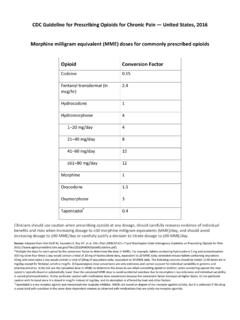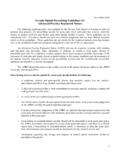Transcription of 2017 Washington State Opioid Response Plan Progress Report ...
1 2017 Washington State Opioid Response Plan Progress Report Activity updates for December 20, 2016 through June 30, 2017. Introduction Since the introduction of the 2016 Washington State Opioid Response Plan (formally the Interagency Opioid Working Plan), four workgroups have met regularly to implement activities in the plan, assess Progress , and identify emerging issues related to Opioid abuse and Opioid overdose in Washington . As activities change, workgroups have modified and added pieces to the work plan. In preparation for implementing Governor Jay Inslee's Executive Order (EO) 16-09, Addressing the Opioid Use Public Health Crisis, and the 2017 Opioid Response Plan activities a Progress Report has been created. This Progress Report highlights completed tasks and identifies areas where work is ongoing. Plan Overview The Washington State Opioid Working Plan includes four priority goals: 1. Prevent Opioid misuse and abuse. 2. Treat Opioid abuse and dependence.
2 3. Prevent deaths from overdose. 4. Use data to detect Opioid misuse/abuse, monitor morbidity and mortality, and evaluate interventions. Collectively, the focused strategies and specific actions to achieve these goals are targeted at: Individuals: Includes those who use prescription opioids and/or heroin at any level of use or dependence. Special populations include pregnant women, adolescents and clients of syringe exchange programs. Professionals: Includes health care providers, pharmacists, first responders/law enforcement, social service providers and chemical dependency professionals. Communities: Includes family members, tribes, local municipalities, schools, community prevention coalitions and citizen groups. Systems: Includes policies, financing structures, and information systems in medical, public health, criminal justice and other fields. Workgroups communicate and meet regularly to assess Progress and identify emerging issues that require new actions.
3 The lead contacts for each workgroup are: Prevention Workgroup (Goal 1): Julia Havens, Division of Behavioral Health and Recovery Jaymie Mai, Department of Labor & Industries Treatment Workgroup (Goal 2): Last Updated September 25, 2017 1|Page Thomas Fuchs, Division of Behavioral Health and Recovery Ahney King, Division of Behavioral Health and Recovery Naloxone Workgroup (Goal 3): Allison Newman, UW Center for Opioid Safety Education Data Workgroup (Goal 4): Jennifer Sabel, Department of Health Last Updated September 25, 2017 2|Page GOAL 1: Prevent inappropriate Opioid prescribing and prevent Opioid misuse and abuse. STRATEGY 1: Promote use of best practices among health care providers for prescribing opioids for acute and chronic pain. Completed, EO. Activity Ongoing or Progress Related EO Activity Goal Inactive The AMDG continues to collaborate with Bree on the development of a dental guideline on prescribing opioids for acute dental pain, prevent inappropriate transition from acute Opioid use to chronic use and avoid Opioid therapy altogether when other alternatives for treating pain may be equally effective.
4 The STR grant will be funding two conferences in Washington State to promote the new Educate health care providers on the AMDG/Bree dental guideline. L&I will lead the planning and 2015 Agency Medical Directors' Group development of the conferences with DSHS, AMDG and Bree. Interagency Guideline for Prescribing AMDG members continue to educate health care providers on the Opioids for Pain, the Washington guideline through presentations, conferences and meetings. Emergency Department Opioid Ongoing Between January 1 and May 31, 2017, there were 254,336 new Prescribing Guidelines and the CDC. and returning visitors to the AMDG website. The top five pages Guideline for Prescribing Opioids for visited include the Opioid Dose Calculator, Other Resources, Chronic Pain to ensure appropriate AMDG Home Page, 2015 AMDG Opioid Guideline and CME. Opioid prescribing. Activities. The University of Washington 's (UW) TelePain Program continues to provide weekly interactive case-based community provider mentoring through tele-video, promoting adherence to the AMDG.
5 And CDC guidelines. Promote the use of the Prescription DOH has provided education and outreach to increase provider Drug Monitoring Program (PMP), use of the PMP at 10 events since January 1, 2017. In addition, Collaborate with partners to explore policies and including use of delegate accounts, DOH is finishing up testing for prescribers of legend drugs to have processes to enhance functionality and increase the among health care providers to help Ongoing access to the PMP. Implementation of delegate accounts for use of the Prescription Drug Monitoring Program identify Opioid use patterns, sedative pharmacists occurred on March 1, 2017 and PMP access for among health care providers. co-prescribing, and indicators of poorly healthcare facilities, as authorized in HB 2730, went live on June 1, coordinated care/access. 2017. DOH continues to provide education and outreach to Last Updated September 25, 2017 3|Page STRATEGY 1: Promote use of best practices among health care providers for prescribing opioids for acute and chronic pain.
6 Completed, EO. Activity Ongoing or Progress Related EO Activity Goal Inactive dispensers regarding daily reporting with enforcement started on January 1, 2017. All COSE presentations on pain and addiction include PMP. promotion. During this period, presentations occurred at UW. Ambulatory Nursing Conference, Mason General Hospital, Washington Academy of Physicians Assistants, Lake Roosevelt Community Health Center and an additional 10 through out the State . Upcoming presentations include WSHA, Public Health Seattle King County, ARNP fall conference, School Health Providers, AETC for HIV care, etc. COSE has drafted an article on safe Opioid use for Nursing Commission publication in May to all licensed nurses. Drafted principles to be shared next quarter with academic centers to promote evidence based pain treatment that is consistent across health service programs. Need to have WA State government sponsor promote it with academic programs.
7 As part of an educational effort to ensure safe and effective care for injured workers, the L&I has developed an annual Opioid prescribing Report that delivers Opioid prescribing information based on PMP data to providers treating injured workers. The Report evaluates Opioid prescribing practices based on three indicators associated with significant risk of severe adverse outcomes: high-dose opioids, concurrent opioids and sedatives, and chronic opioids. Only providers who rank above the mean AND. at or above the 90th percentile on at least one of the three indicators will receive an Opioid prescribing Report . L&I mailed the 2016 Opioid Prescribing Report to 350 providers in April so that they can re-evaluate their prescribing practices. Last Updated September 25, 2017 4|Page STRATEGY 1: Promote use of best practices among health care providers for prescribing opioids for acute and chronic pain. Completed, EO. Activity Ongoing or Progress Related EO Activity Goal Inactive The Bree Collaborative Opioid Prescribing Implementation Workgroup has developed a set of statewide Opioid prescribing metrics critical in tracking State Progress .
8 Metrics are meant to help identify effective strategies to intervene in prescribing practice, providing guidance for health plans, health systems, and individual providers to improve quality of care. The draft metrics have been disseminated to the broader health care community for a four week public comment period from May 25 to June 23 and will be presented to the Bree Collaborative for adoption in July. The workgroup is collaborating with Oregon Health Authority for possible adoption of the metrics and is also in discussion with the Centers for Disease Control and Prevention about adoption. UW and HCA continues to offer pain management resources for community-practice providers such as TelePain and Opioid Consult Train, coach and offer consultation Hotline. The TelePain Program continues to provide weekly with providers on guideline-adherent interactive case-based community provider mentoring through Develop tele-mentoring prescriber education Opioid prescribing and non- Opioid tele-video with current financial support from HCA, the Governor's programs, such as the UW TelePain, to be a fiscally alternatives for pain management office and the State Targeted Response (STR) to the Opioid Crisis Ongoing sustainable telehealth service.
9 Establish support ( , TelePain video conferencing and Grant. Unfortunately, UW has encountered obstacles to programs for providers, like an Opioid prescribing Opioid consultation hotline). developing a sustainable funding model that would enable consultation hotline. enhancement and wide promotion of this service. TelePain webinar series participation ranges from 194-245 attendees per month. The Opioid Consult Hotline provides just in time advice for providers caring for patients with complex chronic pain problems. Partner with professional associations, The Bree Collaborative has held two summits on Opioid prescribing Consider amendments to the State pain guidelines teaching institutions, boards and in dentistry on March 9 and on June 22, convening representatives and other training and policy materials, consistent commissions and insurers to reduce from the Washington State Dental Association, the University of with the 2015 AMDG and the 2016 CDC Opioid Ongoing unnecessary Opioid prescribing for Washington School of Dentistry, the Dental Quality Assurance guidelines, to reduce unnecessary prescribing for acute pain conditions especially in the Commission, the Washington State Hospital Association, the acute pain conditions for the general population, and adolescent population.
10 Washington State Medical Association, Delta Dental, individual especially for adolescents. Last Updated September 25, 2017 5|Page STRATEGY 1: Promote use of best practices among health care providers for prescribing opioids for acute and chronic pain. Completed, EO. Activity Ongoing or Progress Related EO Activity Goal Inactive dentists, and others to develop recommendations specific to dental providers. Gov. Jay Inslee signed House Bill 1427 into law on May 16 to help address the Opioid crisis. DOH is beginning the rule making process for this legislation which will involve developing Opioid prescribing rules. WSU, Pacific NW University and UW interdisciplinary programs Enhance medical, nursing, and have all agreed to work on an interdisciplinary curriculum project physician assistant school curricula on teaching about safe Opioid prescribing. The UMASS Medical School Ongoing pain management, PMP, and has been contacted to provide more information about their treatment of Opioid use disorder.


